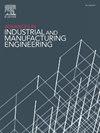Melting modes of laser powder bed fusion (L-PBF) processed IN718 alloy: Prediction and experimental analysis
Abstract
The present study explores a combination of numerical and simulation approaches to generate a process map for identifying the regimes of conduction and keyhole modes of melting and verify the same with experimental data. Finite Element based simulation studies were conducted to determine the regions of conduction mode, keyhole mode, and transition by varying the laser power and speed. Single tracks and density cubes were processed based on the simulation results to confirm the melting modes and study its effect on microstructure and hardness. Increase in volumetric energy density (VED) causes a shift in microstructure of single tracks, from a mix of short columnar and equiaxed grains in conduction mode to long columnar grains in keyhole mode, with an overall increase in the grain size. The melt pool depth to width ratio also increases with VED. The VED based criteria alone cannot determine melting modes as the single-track samples at 81 J/mm3 exhibited both conduction mode (at 250 W) and keyhole mode (at 350 W). Almost all the printed cubes showed high density (>99.9%) irrespective of melting mode. Similar to single track the average grain size of bulk samples increased with increase in VED. The bulk samples were subjected to three different heat treatments (Homogenisation, Solution treatment and Direct Double Aging) to study their effect on the microstructures and mechanical properties. Homogenisation resulted in near identical equiaxed microstructure irrespective of processing parameters. The highest hardness of about 470 HV was observed for the direct double aged samples.

 求助内容:
求助内容: 应助结果提醒方式:
应助结果提醒方式:


